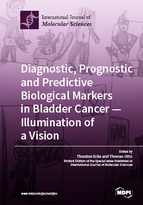Diagnostic, Prognostic and Predictive Biological Markers in Bladder Cancer – Illumination of a Vision
A special issue of International Journal of Molecular Sciences (ISSN 1422-0067). This special issue belongs to the section "Molecular Pathology, Diagnostics, and Therapeutics".
Deadline for manuscript submissions: closed (31 December 2018) | Viewed by 64890
Special Issue Editors
Interests: bladder cancer; prostate cancer; urologic oncology; molecular biology; tumor markers; diagnostics; biomarkers in urological malignancies
Special Issues, Collections and Topics in MDPI journals
Interests: endourology; bladder cancer; urologic oncology; molecular biology
Special Issues, Collections and Topics in MDPI journals
Special Issue Information
Dear Colleagues,
Bladder cancer is the most common cancer of the urinary tract and ranks fifth among cancers in men in Western countries. Early diagnosis of bladder cancer is mainly based on cystoscopy after gross hematuria. Based on urine or urinary cells, only a few molecular markers have been approved by the Federal Food and Drug Administration (FDA) so far. Urine soluble markers should be able to ensure primary diagnosis, follow-up control and screening of high-risk populations. In addition, these markers are designated merely as supporting tools for monitoring bladder cancer patients instead of replacing cystoscopy. New biomarkers in serum and urine including nucleic acid or protein-based tissue biomarkers have been described. However, not only the diagnosis, but also the prognosis or further prediction of this very common disease is important to know. To say it in Arthur Rimbaud’s words, the vision of new scientific reports should be illuminated in this Special Issue with focus on “Diagnostic, Prognostic and Predictive Biological Markers in Bladder Cancer—Illumination of a Vision”.
We warmly welcome submissions, including original papers and reviews, on this widely-discussed topic.
Assoc. Prof. Dr. Thorsten EckeProf. Dr. Thomas Otto
Guest Editors
Manuscript Submission Information
Manuscripts should be submitted online at www.mdpi.com by registering and logging in to this website. Once you are registered, click here to go to the submission form. Manuscripts can be submitted until the deadline. All submissions that pass pre-check are peer-reviewed. Accepted papers will be published continuously in the journal (as soon as accepted) and will be listed together on the special issue website. Research articles, review articles as well as short communications are invited. For planned papers, a title and short abstract (about 100 words) can be sent to the Editorial Office for announcement on this website.
Submitted manuscripts should not have been published previously, nor be under consideration for publication elsewhere (except conference proceedings papers). All manuscripts are thoroughly refereed through a single-blind peer-review process. A guide for authors and other relevant information for submission of manuscripts is available on the Instructions for Authors page. International Journal of Molecular Sciences is an international peer-reviewed open access semimonthly journal published by MDPI.
Please visit the Instructions for Authors page before submitting a manuscript. There is an Article Processing Charge (APC) for publication in this open access journal. For details about the APC please see here. Submitted papers should be well formatted and use good English. Authors may use MDPI's English editing service prior to publication or during author revisions.
Keywords
- urinary biomarkers on bladder cancer
- serum/plasma biomarkers
- tissue biomarkers (nuleic acid/protein-based)
- epigenetic markers
- prognostic factors
- predictive factors
- multivariate models







